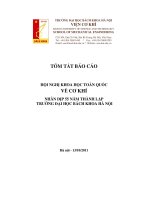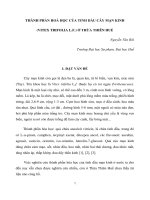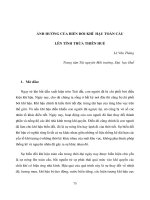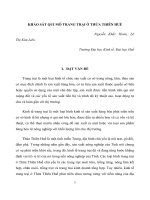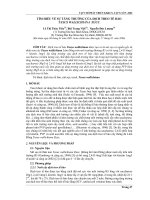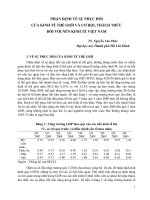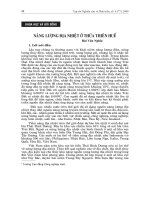Báo cáo nghiên cứu khoa học: "Nghiên cứu về sự phổ biến của HBsAg seropositivity ở những người ở Thừa Thiên Huế" ppsx
Bạn đang xem bản rút gọn của tài liệu. Xem và tải ngay bản đầy đủ của tài liệu tại đây (68.84 KB, 6 trang )
269
JOURNAL OF SCIENCE, Hue University, N
0
61, 2010
STUDY ON THE PREVALENCE OF HBsAg SEROPOSITIVITY
IN PEOPLE IN THUA THIEN HUE PROVINCE
Ngo Viet Loc
College of Medicine and Pharmacy, Hue University
SUMMARY
Hepatitis B infection is caused by the hepatitis B virus (HBV).
About 400 million people
across the world are chronically infected by the hepatitis B virus. Hepatitis B is a leading cause
of chronic hepatitis, cirrhosis, and hepatocellular carcinoma, accounting for 1 million deaths
annually. In Asia, the rate of hepatitis B surface antigen (HBsAg) carriage in the general
population ranges from 2% to 20%. The aim of this study were to determine the percentage of
positive hepatitis B surface antigen of people aged 6 and over in Thua Thien Hue Province.
Methodology: A cross sectional descriptive study was conducted from 2006 to 2008, including
2,525 people aged 6 years and over who were living in four ecological areas of Thua Thien Hue
Province: mountainous, low land, coastal and Hue city (urban). These people were detected the
hepatitis B surface antigen (HBsAg) by enzyme immunoassay and interviewed by questionnaire.
Results: The overall prevalence of the HBsAg positive was 16.36%, analysis of sex in the group
of HBsAg positive: the prevalence of HBsAg positive in females was higher than in males
(21.14% and 12.05%), HBsAg positive and age groups: the HBsAg positive prevalence was the
highest in the age groups of 20 - 19 (22.34%) and 31 - 40 (20.17%). HBsAg positive and
occupation: the highest prevalence of HBsAg positive (26.43%) was found among manual
workers. HBsAg positive and ecological areas: The prevalence of HBsAg positive in coastal
area was the highest (20.15%). Conclusion: The prevalence of the HBsAg positive of people
aged 6 and over in Thua Thien Hue province was 16.36%. Accordingly, public measures to
control HBV infection are needed.
Key word: Infection of HBV
1. Introduction
Hepatitis B virus (HBV) infection is a global public health problem and it has
been estimated by the World Health Organization (WHO) that 2,000 million people (one
third of the world's population) have been infected worldwide.
Hepatitis B infection is caused by the hepatitis B virus (HBV). Of these, about
400 million people are chronically infected carriers, of which 75% reside in the Asian
region. Of the carriers, 25% are at risk of serious illness and eventual death from
270
cirrhosis or hepato-cellular carcinoma (HCC).
The prevalence of chronic HBV infection is endemic in many countries of Asia and
Africa and it has been estimated as 2.8% in developing countries and 7.6% in developing
countries. HBV infection in the Asia-Pacific region is among the highest in the world, and
chronic HBV infection in most of the countries of the Asia-Pacific region is high (>10%
prevalence).
However, there is a wide variation of HBV infection in the Asia-Pacific Region.
The prevalence is low (<1%) in Australia and New Zealand, 1-5% in Japan, Singapore,
India and Thailand, 6-10% in Bangladesh, Indonesia and northern China and highest
(>10%) in Taiwan, southern China, Korea, Philippines, Melanesia, Micronesia and
Polynesia.
Vietnam is also regarded as a country with a high endemicity of HBV infection.
The study of Vietnam National Institute of Hematology and Blood transfusion has
recorded a HBsAg prevalence of 11.1% in blood donors. Two other studies in Ho Chi
Minh City and Ha Noi have given the prevalence of HBsAg been 14.8% and 14.4%.
In Thua Thien Hue Province, Nguyen Ngoc Minh et al found the HBsAg
prevalence of 13.57% in blood donors. Pham Van Linh and Tran Thi Minh Diem have
gieven the rate of 16.8% in 1,478 aged 3 years and over.
Health authorities in Vietnam have taken various steps to control and manage
HBV infection. It has been regarded as a priority disease in the National Health Plans.
The purpose of this study was to determine the seroprevalence of hepatitis B
virus surface antigen (HBsAg) in people aged 6 years old and over, in Thua Thien Hue
Province.
2. Methods
The descriptive, cross-sectional study from 2006 to January 2008 was carried
out on 2,525 people aged 6 years and over in Thua Thien Hue which is located in
central zone of Vietnam.
The study population was randomly selected using stratified sampling to size.
The subject matter of ecology of Thua Thien Hue province is normally divided into four
areas: mountainous, low land, coastal and Hue city (urban). Each ecological area was
randomly selected two communes or two wards. The study population of each
commune or ward was selected using simple random sampling.
These people were detected the hepatitis B virus surface antigen (HBsAg) by
enzyme immunoassay. Information was collected from them by interviewing and asking
to fill up the questionnaire given to them at the time of collecting blood samples.
Information included general data like sex, age, occupation etc.
The chi-square test was used to assess the significance of the difference among
271
the groups. A p-value of < 0.05 was considered significant.
3. Results
A total of 2,525 people aged ≥ 6 years old were tested for HBsAg. This number
was made up of 1,197 males and 1,328 females. Of these, 413 people were positive for
HBsAg, giving an overall prevalence of 16.36%. It was shown in table 1.
Table 1. The overall prevalence of the HBsAg positive
HBsAg No. of subjects Prevalence (%)
HBsAg positive 413 16.36
HBsAg negative 2,112 83.64
Total number tested 2,525 100.00
Table 2. Sex-wise distribution of HBsAg positive cases
Sex No. of subjects HBsAg positive
Male 1,197 253 21.14%
Female 1,328 160 12.05%
HBsAg seroprevalence rate among the males was 21.14%, while it was 12.05%
among the females. The difference in positivity between males and females was
statistically significant (p < 0.05).
Table 3. Age-wise distribution of HBsAg positive cases
Age groups (years) No. of subjects HBsAg positive
6 - 14 570 58 10.18%
15 - 19 206 33 16.02%
20 - 29 282 63 22.34%
30 - 39 620 125 20.17%
40 - 49 511 77 15.07%
50 - 59 286 52 18.19%
≥ 60 50 5 10.00%
Table 3 showed the HBsAg positive prevalence was the highest in the age
groups of 20 - 19 (22.34%) and 31 - 40 (20.17%), while it was 10.18% and 10% in the 6
-14 and the ≥ 60 years age. This difference was statistically significant (p < 0.05).
272
Table 4. Occupational distribution of HBsAg positive cases
Occupation No. of subjects HBsAg positive
Staff 367 54 14,72%
Pupils -students 558 73 13,09%
Businessmen 360 59 16,39%
Manual workers 246 65 26,43%
Farmers 732 123 16,81%
elderly persons - housewives 262 41 15,65%
The highest prevalence of HBsAg positive (26.43%) was found among manual
workers. This difference was statistically significant (p < 0.05).
Table 5. Ecological areas distribution of HBsAg positive cases
Ecological areas No. of subjects HBsAg positive
Hue City (Urban) 853 120 14.07%
Low land 917 148 16.14%
Coastal 536 108 20.15%
Mountainous 219 37 16.90%
In relation to ecological areas, the coastal area had the highest rate of HBsAg
positive (20, 15%) followed by the areas where were mountainous (16, 90%) and low
land (16.14%), while Hue City (urban) had 14.07%. The difference in positivity
between four areas was statistically significant (p < 0.05).
4. Discussion
Our study showed HBsAg prevalence rate of 16.36% among 2,525 people aged
≥ 6 years old were tested for HBsAg.
This is similar to the findings of Pham Van Linh and Tran Thi Minh Diem
but
higher than that observed in some of the previous studies in different parts of Vietnam.
The prevalence was 13.57% in blood donors in Thua Thien Hue Province as per the
study of Nguyen Ngoc Minh et al (from 1997 to 2001).
This difference might be come
from the fact that most of them were staffs, students and pupils. In addition, the carriers
did not participate to donate blood in the study. Pham Hoang Phiet (2005) obtained a
lower HBsAg prevalence of 4.8% in people that were tested for HBsAg before
vaccination. This may be due to the fact that most of the participants in the present
study had good knowledge of HBV.
273
Seropositivity was significantly more in males (21.14%) than females (12.05%).
This difference was statistically significant (p-value <0.001). In earlier studies such as
Tran Thi Chinh et al (1993), Hoang Thuy Long (1995) and Pham Van Linh and Tran Thi
Minh Diem (2006) also have made similar observations. This might be due to the fact
that males have many risk factors of HBV infection.
Age distribution showed that the two highest rates of HBsAg positivity (22.34%
and 20.17%) were in the age groups of 20 - 29 and 30 - 39. This was similar to the
findings of Dao Dinh Duc et al (1997) and Pham Van Linh and Tran Thi Minh Diem
(2006). The lowest rate of HBsAg positivity (10%) was in ≥ 60 years age group. The
explanation for this observation was that the low number of subjects studied in the older
age group.
Occupational breakdown showed that manual workers had the highest rate of
HBsAg positivity (26, 43%). The results of our study were similar to that recorded in
previous study of Pham Van Linh and Tran Thi Minh Diem. This might be due to the
fact that most of manual workers had not been vaccinated against hepatitis-B yet.
Another reason is that their knowledge of prevention of HBV infection was still not
good.
Among four ecological areas studied, coastal area had the highest HBsAg
prevalence (20.15%). This is similar to the findings of Pham Van Linh and Tran Thi
Minh Diem (2006).
The traffic system of communes belong to coastal area was not
advantageous yet. Means of transport here is mainly by boats. It is difficult for people to
take them to reach the places where have vaccination. Moreover, people in this area did
not pay attention to knowledge of HBV.
5. Conclusion
The overall prevalence of the HBsAg positive in people aged 6 years and over in
Thua Thien Hue province was 16.36%. The prevalence of HBsAg positive in females
was higher than in males (21.14% and 12.05%). The HBsAg positive prevalence was
the highest in the age groups of 20 - 19 (22.34%) and 31 - 40 (20.17%). The highest
prevalence of HBsAg positive (26.43%) was found among manual workers. The
prevalence of HBsAg positive in coastal area was the highest (20.15%).
Therefore, hepatitis B vaccination should be incorporated into routine childhood
immunization programmers for all regions in Vietnam because hepatitis B vaccination
remains the most important aspect of prevention of hepatitis B virus infection.
274
REFERENCES
1. Aggarwal R, Ranjan P. Preventing and treating hepatitis B infection. BMJ. 2004
Nov 6; 329(7474): 1080-6.
2. Bosch FX: Global epidemiology of hepatocellular carcinoma. In: Liver Cancer.
(Eds: Okuda K, Tabor E), Churchill Livingstone, New York, 1997: 13-28.
3. Cao Ngoc Nga et al. The infection of HBV in people going to vaccinate in Ho
Chi Minh City from 2001 to 2002. Journal of practical medicine. 2003; 2: 111-
113.
4. Dao Dinh Duc et al. Epidemiology of HBV in Vietnam. Journal of practical
medicine. 1997; 9: 1-3.
5. Hoang Thuy Long et al. The infection of HBV and HCV in Thanh Hoa province.
Journal of preventive medicine. 1995; 9(2): 5-9
6. Lin KW, Kirchner JT. Hepatitis B. Am Fam Physician. 2004 Jan 1;69(1): 75-82.
7. Loh KY, Kew ST. Hepatitis B infection: what the primary care doctors should
know. Malaysian Family Physician. 2006; 1(1): 8-10.
8. Nair S, Perrillo RP:Hepatitis B and D. In: Hepatology. A Textbook of Liver
Disease, ed 4. (Eds: Zakim D, Boyer TD), Saunders, Philadelphia. 2003; 959-
1016.
9. Nguyen Ngoc Minh et al. Study on the prevalence of HBsAg and anti HCV in
blood donors in Thua Thien Hue province from 1997 to 2001. Journal of
practical medicine. 2002; 2: 111-113.
10. Pham Van Linh, Tran Thi Minh Diem et al. Study on the infection of HBV in
people aged 3 and over in Thua Thien Hue province. Journal of practical
medicine. 2005; 2: 82-85.
